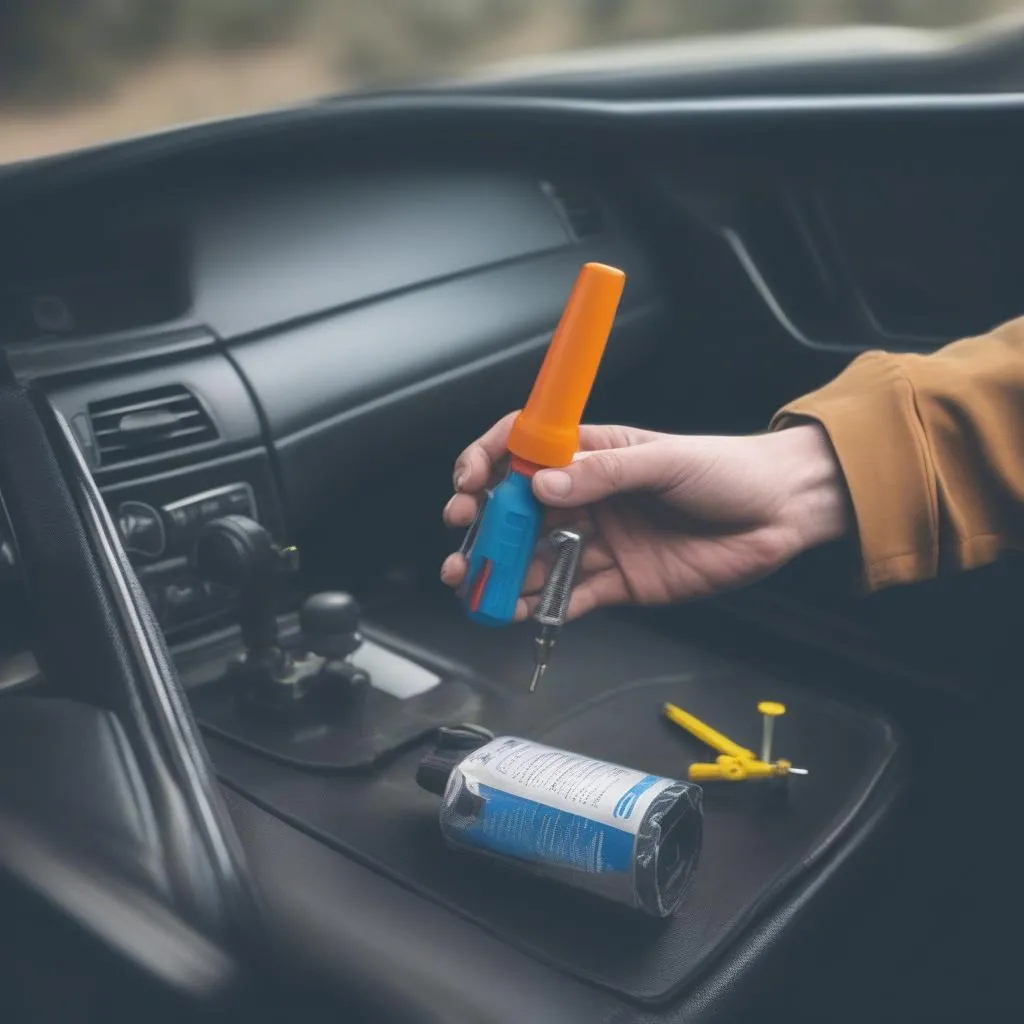Experiencing a recurring brake warning light and chime on your Jeep Wrangler can be unnerving. This issue, while common, can stem from a variety of reasons, ranging from simple fixes to more complex problems requiring professional attention. This guide will delve into the possible causes, provide troubleshooting tips, and outline solutions to help you regain peace of mind on the road.
Understanding Your Jeep Wrangler’s Brake System
Your Jeep Wrangler’s braking system is a complex network of components working together to ensure safe and efficient stopping power. When you press the brake pedal, you’re activating a hydraulic system that transmits force to the calipers, squeezing the brake pads against the rotors to slow down or stop the vehicle. Any fault within this system can trigger the brake warning light and chime.
Common Causes of a Jeep Wrangler Brake Warning Light and Chime
1. Low Brake Fluid Level
One of the most common culprits behind a persistent brake warning light is low brake fluid. Brake fluid is the lifeblood of your braking system, transmitting the force from your foot to the brakes. As brake pads wear down, the fluid level in the master cylinder naturally drops. However, if the fluid level drops significantly, it could indicate a leak, which needs immediate attention.
Troubleshooting Tip: Check the brake fluid level in the master cylinder reservoir, located under the hood on the driver’s side. If the level is below the “MIN” mark, add the recommended DOT 3 or DOT 4 brake fluid.
2. Worn Brake Pads
Brake pads are designed to wear down over time, and when they reach a critical thickness, the brake warning light will illuminate. Worn brake pads not only compromise your braking performance but can also damage the rotors, leading to costly repairs.
Troubleshooting Tip: Visually inspect your brake pads through the spaces between the wheel spokes. If the pad material is less than 1/4 inch thick, it’s time for a replacement.
3. Faulty Brake Light Switch
While it may seem unrelated, a faulty brake light switch can also trigger the brake warning light. The brake light switch activates the brake lights when you press the pedal. If this switch malfunctions, it can disrupt the electrical signals within the braking system, causing the warning light to illuminate.
Troubleshooting Tip: Ask a helper to observe the brake lights while you press the pedal. If the lights don’t illuminate, the brake light switch is likely faulty and needs replacement.
4. ABS System Malfunction
Modern Jeep Wranglers are equipped with an Anti-lock Braking System (ABS), designed to prevent wheel lock-up during hard braking. The ABS system relies on sensors to monitor wheel speed and modulate brake pressure to maintain traction. A malfunction within the ABS system, such as a faulty wheel speed sensor, can trigger the brake warning light.
Troubleshooting Tip: If you suspect an ABS issue, it’s best to consult a qualified mechanic or use a diagnostic scanner to read the ABS error codes.
5. Issues with the Electronic Brake Control Module (EBCM)
The EBCM is the brain of your Jeep Wrangler’s electronic braking system. It receives signals from various sensors and controls the ABS and traction control systems. While rare, a malfunctioning EBCM can lead to various braking system issues, including a constantly illuminated brake warning light.
Troubleshooting Tip: Diagnosing and repairing an EBCM issue requires specialized knowledge and equipment. Consult a certified Jeep technician or a qualified mechanic specializing in automotive electronics for assistance.
What to Do When Your Jeep Wrangler’s Brake Warning Light Comes On
1. Don’t Panic: A illuminated brake warning light doesn’t necessarily mean imminent brake failure. However, it’s a crucial signal that requires your immediate attention.
2. Assess the Situation: If possible, safely pull over to a safe location and assess the situation. Check for any unusual noises, smells, or sensations while braking.
3. Check the Brake Fluid: As mentioned earlier, low brake fluid is a common cause. If the level is low, add the recommended brake fluid and monitor the situation.
4. Inspect the Brake Pads: Visually inspect the brake pads for wear. If they appear worn, consider replacing them.
5. Seek Professional Help: If the warning light persists or you suspect a more complex issue, consult a qualified mechanic or a certified Jeep dealership for a thorough inspection and diagnosis.
Remote Diagnostics and Software Solutions: The Future of Jeep Repair
Advancements in automotive technology have paved the way for remote diagnostics and software solutions, offering convenient and efficient ways to diagnose and address issues with your Jeep Wrangler’s braking system.
Remote Diagnostics: Some manufacturers and specialized service providers offer remote diagnostics, where a technician can remotely access your vehicle’s computer system to read error codes and diagnose the root cause of the problem.
Software Updates and Programming: Software plays a critical role in modern vehicles, including the braking system. Remote software updates and programming can address software glitches and optimize the performance of your braking system.
Conclusion
A recurring brake warning light and chime in your Jeep Wrangler should never be ignored. While the issue could be as simple as low brake fluid or worn brake pads, it could also indicate a more complex problem requiring professional attention. By understanding the common causes, troubleshooting tips, and seeking timely assistance when needed, you can ensure your Jeep Wrangler’s braking system remains in optimal condition, providing you with safe and reliable stopping power for miles to come.

